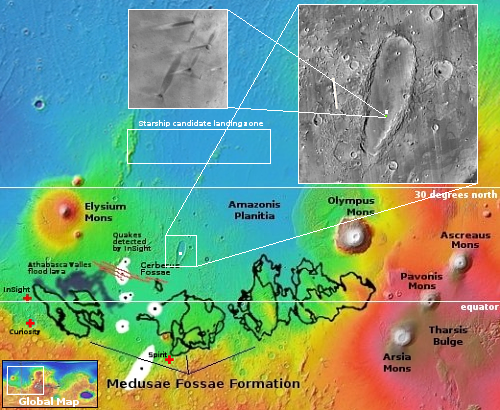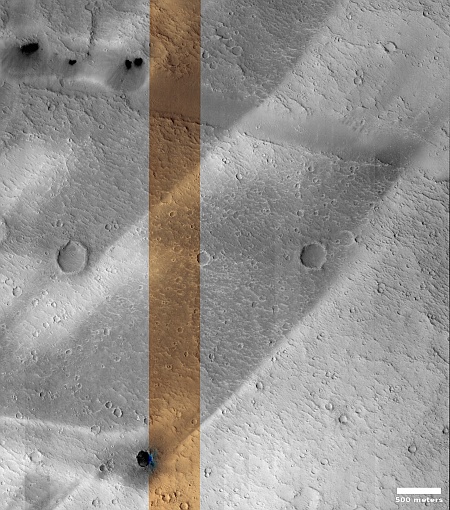Another “What the heck?” image on Mars, this time a mystery on both small and large scales
Cool image time! The picture to the right, rotated, cropped, reduced, and sharpened to post here, was taken on October 21, 2024 by the high resolution camera on Mars Reconnaissance Orbiter (MRO). Labeled simply as a “terrain sample,” it was likely taken not as part of any specific research project but to fill a gap in the schedule in order to maintain the camera’s proper temperature.
In this case however the camera team picked this spot probably to satisfy their own curiosity. This same location was photographed by MRO back in July 2022, and they were likely wondering if the streaks coming off these dark spots had changed at all in the subsequent years.
As far as I can tell, there has been no significant change, though the highest resolution versions of these images might show more.
The geology in the picture itself is very puzzling. At first glance the dark streaks appear to have been caused by wind blowing the dust from the dark spots. At second glance this doesn’t work, as large dark areas do not appear to be linked to those dark spots.
What is going on here?

The white dot on the overview map to the right marks the location, inside the strange oblong depression on Mars dubbed Orcus Patera. On January 29 2024 the MRO camera team chose the 2022 image of this location as its MRO picture of the day, where they wrote the following:
This public target from HiWish requested to investigate the relationship between the dark spots in the fossa and surrounding dark mantle deposits. Orcus Patera was first imaged by Mariner 4, and is a depression about 380 kilometers long and 140 kilometers wide. Its formation is unknown.
The 2022 image was requested by a non-scientist using MRO’s HiWish system (available to anyone), and this new image was a follow-up by the camera team. The second smaller inset on the overview map, showing a close-up of the area marked by the green dot slightly to the south, helps explain partly the streaks, Apparently there are two prevailing winds at this location, resulting in streaks blowing to the west and to the northeast. The westerly wind apparently spreads out the northeast streaks, explaining the larger dark areas in the first picture above.
Why the westerly streaks are not as spread however remains a puzzle. Also puzzling are these two prevailing winds. Why are there two such distinct winds? Are they seasonal, during different seasons? Or maybe the northeasterly is from a much earlier time, no longer blows, and is now being reshaped by the westerlies that are now prevalent.
Nor are the winds the only mystery. Why are these craters filled with dark dust? And on a much larger scale, Orcus Patera is a bafflement. As the caption notes, we don’t know what formed Orcus Patera. It looks like it is an impact crater formed by a very oblique impact, but that is not certain. It is also possible it was a volcanic vent, as it is located in a vast region covered with flood lava.
On Christmas Eve 1968 three Americans became the first humans to visit another world. What they did to celebrate was unexpected and profound, and will be remembered throughout all human history. Genesis: the Story of Apollo 8, Robert Zimmerman's classic history of humanity's first journey to another world, tells that story, and it is now available as both an ebook and an audiobook, both with a foreword by Valerie Anders and a new introduction by Robert Zimmerman.
The print edition can be purchased at Amazon or from any other book seller. If you want an autographed copy the price is $60 for the hardback and $45 for the paperback, plus $8 shipping for each. Go here for purchasing details. The ebook is available everywhere for $5.99 (before discount) at amazon, or direct from my ebook publisher, ebookit. If you buy it from ebookit you don't support the big tech companies and the author gets a bigger cut much sooner.
The audiobook is also available at all these vendors, and is also free with a 30-day trial membership to Audible.
"Not simply about one mission, [Genesis] is also the history of America's quest for the moon... Zimmerman has done a masterful job of tying disparate events together into a solid account of one of America's greatest human triumphs."--San Antonio Express-News
Cool image time! The picture to the right, rotated, cropped, reduced, and sharpened to post here, was taken on October 21, 2024 by the high resolution camera on Mars Reconnaissance Orbiter (MRO). Labeled simply as a “terrain sample,” it was likely taken not as part of any specific research project but to fill a gap in the schedule in order to maintain the camera’s proper temperature.
In this case however the camera team picked this spot probably to satisfy their own curiosity. This same location was photographed by MRO back in July 2022, and they were likely wondering if the streaks coming off these dark spots had changed at all in the subsequent years.
As far as I can tell, there has been no significant change, though the highest resolution versions of these images might show more.
The geology in the picture itself is very puzzling. At first glance the dark streaks appear to have been caused by wind blowing the dust from the dark spots. At second glance this doesn’t work, as large dark areas do not appear to be linked to those dark spots.
What is going on here?

The white dot on the overview map to the right marks the location, inside the strange oblong depression on Mars dubbed Orcus Patera. On January 29 2024 the MRO camera team chose the 2022 image of this location as its MRO picture of the day, where they wrote the following:
This public target from HiWish requested to investigate the relationship between the dark spots in the fossa and surrounding dark mantle deposits. Orcus Patera was first imaged by Mariner 4, and is a depression about 380 kilometers long and 140 kilometers wide. Its formation is unknown.
The 2022 image was requested by a non-scientist using MRO’s HiWish system (available to anyone), and this new image was a follow-up by the camera team. The second smaller inset on the overview map, showing a close-up of the area marked by the green dot slightly to the south, helps explain partly the streaks, Apparently there are two prevailing winds at this location, resulting in streaks blowing to the west and to the northeast. The westerly wind apparently spreads out the northeast streaks, explaining the larger dark areas in the first picture above.
Why the westerly streaks are not as spread however remains a puzzle. Also puzzling are these two prevailing winds. Why are there two such distinct winds? Are they seasonal, during different seasons? Or maybe the northeasterly is from a much earlier time, no longer blows, and is now being reshaped by the westerlies that are now prevalent.
Nor are the winds the only mystery. Why are these craters filled with dark dust? And on a much larger scale, Orcus Patera is a bafflement. As the caption notes, we don’t know what formed Orcus Patera. It looks like it is an impact crater formed by a very oblique impact, but that is not certain. It is also possible it was a volcanic vent, as it is located in a vast region covered with flood lava.
On Christmas Eve 1968 three Americans became the first humans to visit another world. What they did to celebrate was unexpected and profound, and will be remembered throughout all human history. Genesis: the Story of Apollo 8, Robert Zimmerman's classic history of humanity's first journey to another world, tells that story, and it is now available as both an ebook and an audiobook, both with a foreword by Valerie Anders and a new introduction by Robert Zimmerman.
The print edition can be purchased at Amazon or from any other book seller. If you want an autographed copy the price is $60 for the hardback and $45 for the paperback, plus $8 shipping for each. Go here for purchasing details. The ebook is available everywhere for $5.99 (before discount) at amazon, or direct from my ebook publisher, ebookit. If you buy it from ebookit you don't support the big tech companies and the author gets a bigger cut much sooner.
The audiobook is also available at all these vendors, and is also free with a 30-day trial membership to Audible.
"Not simply about one mission, [Genesis] is also the history of America's quest for the moon... Zimmerman has done a masterful job of tying disparate events together into a solid account of one of America's greatest human triumphs."--San Antonio Express-News



Mr Z.
Just curious, as a space outsider loving your work,, are there other, or many, instances of this oblique impact signature, either on Mars (with atmosphere) or vs the Moon (no atmosphere)? In the long term would seem there is deep science, or at least a few theses’, in the statistical analysis of such, given of course they are impact signatures? Internal venting entirely different story.
John S.
John Schneider: There are a handful of other oblong craters that suggest an oblique impact, but many fewer than one would think.
Research in the 1990s using pellets impacting a variety of surfaces and material and in a variety of atmosphere found consistently that unless an oblique impact was very extreme, the crater formed would be round. The object had to hit the ground almost sideways for an oblong crater to form.
The result was counter-intuitive. I remember watching the scientist who did this research report it and comment on this fact.
Could it be that the dark craters are simply due to the craters being much deeper and thus dark? Maybe there’s a mantle or layer of crust that some object impacted and broke through creating a hole while the other craters were from object that merely impacted and blew away part of the surface.